Plugging the skills gap one leak at a time
Recent news reports of sewage spills in the Vaal Dam have again raised concerns over South Africa’s water resources. In order to reduce the costs of maintaining the country’s water network, government has embarked on a programme to train unemployed youth with skills to patch up ageing infrastructure.
An important tool to fight joblessness is skills development for the youth. The unemployment rate for those aged 15-34 currently stands at 38,9%, higher than the overall rate of 27,2%. In other words, just over one in three of the 10 million aspiring young people participating in the labour force (i.e. those either working or actively looking for work) did not have a job in the second quarter of 2018.1 The unemployment rate for those aged 15-24 is much higher, standing at 53,7%.
A high unemployment rate can be tackled from two fronts. First, from the demand side, by increasing economic growth and job opportunities, and second, from the supply side, by improving the skills of the workforce.
In 1998, parliament passed the Skills Development Act that formed the groundwork for the Sector Training and Education Authority (SETA) system. The system currently consists of 21 institutions (referred to as SETAs) that focus on developing training programmes and internships in particular industries.
Stats SA’s latest Financial statistics of extra-budgetary accounts and funds report provides financial data for all SETAs. The chart below shows the change in income for the 21 institutions, highlighting the following SETAs: Services SETA (education and training), merSETA (manufacturing and engineering), MQA (mining), W&RSETA (wholesale and retail), CETA (construction), and EWSETA (energy and water).
Notice the jump in the amount of income received by the Energy and Water Sector Education and Training Authority (EWSETA)? A cash injection from the Department of Water and Sanitation pushed EWSETA up the ranks from 10th in 2016 to 2nd in 2017 in terms of income received by the SETAs.
Closer inspection of the EWSETA annual report reveals that this increase was mostly for the War on Leaks (WoL) project.2 This project aims to train 15 000 school leavers to become fitters and turners, plumbers, welders, and electricians. Once trained, this small army of artisans will target ageing infrastructure across the country to curb water losses.
With an overall vacancy rate of 15% in municipal water and waste water management departments across the country,3 developing these kinds of skills will aid in maintaining our water infrastructure.
For more information, download the Financial statistics of extra-budgetary accounts and funds 2016/2017 report here.
1 Stats SA, Quarterly Labour Force Survey (QLFS), 2nd quarter 2018 (download the release
here).
2 EWSETA, Annual Report, 2016/17 (download here).
3 Municipal vacancy rates are available in Table 2.2 in the Non-financial census of municipalities for the year ended 30 June 2017 report (download here).
Similar articles are available on the Stats SA website and can be accessed here.
For a monthly overview of economic indicators and infographics, catch the latest edition of the Stats Biz newsletter here


